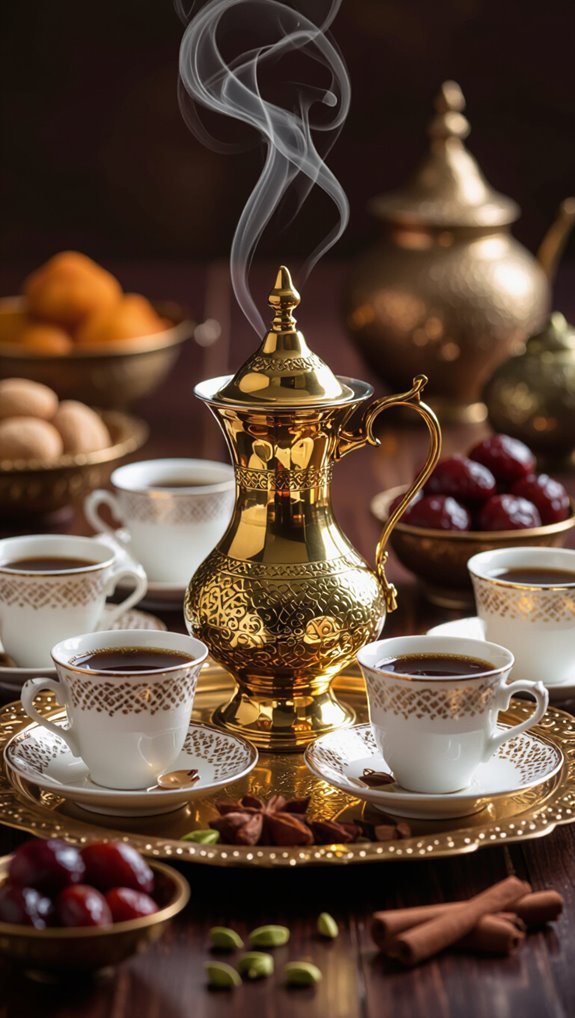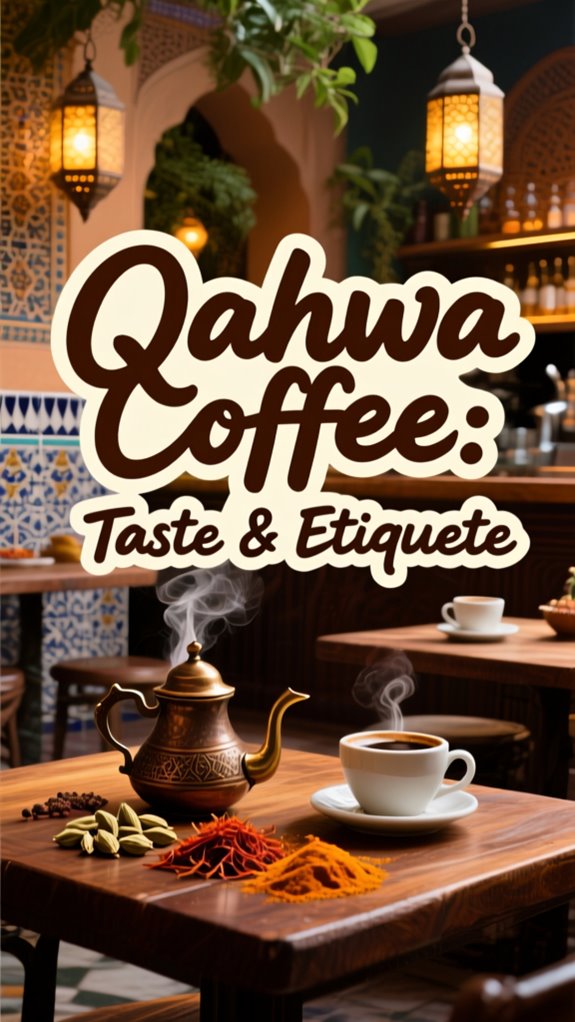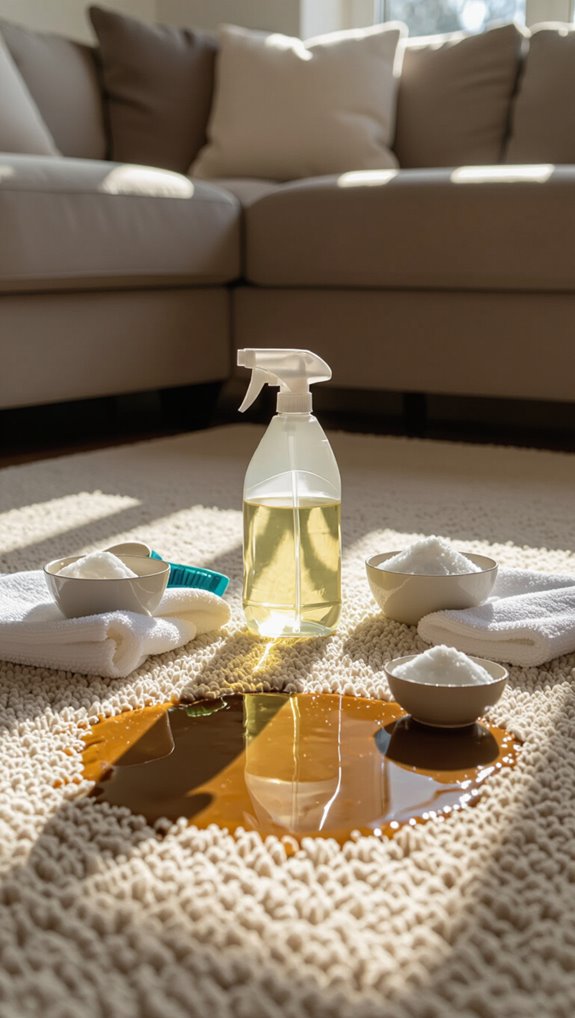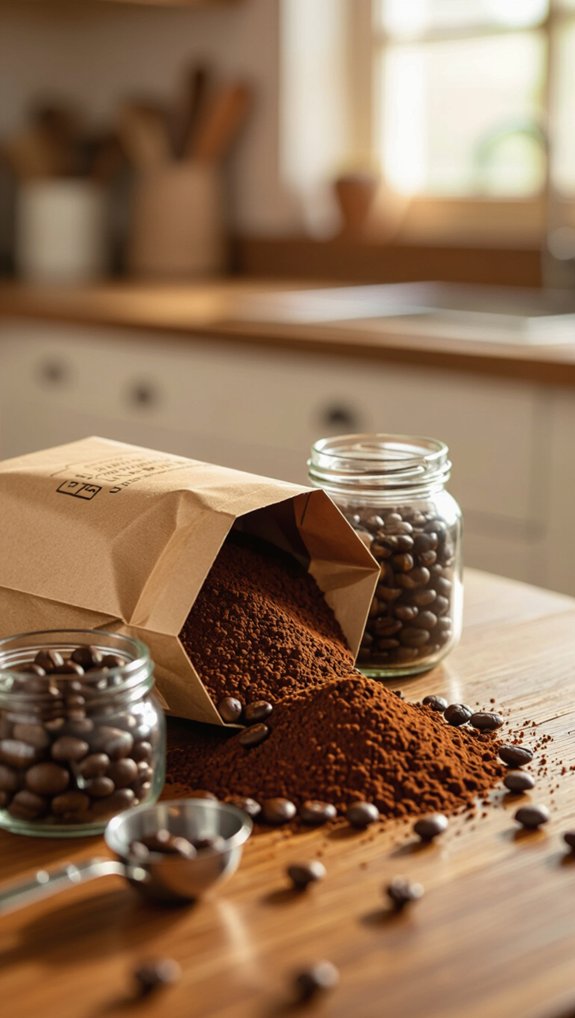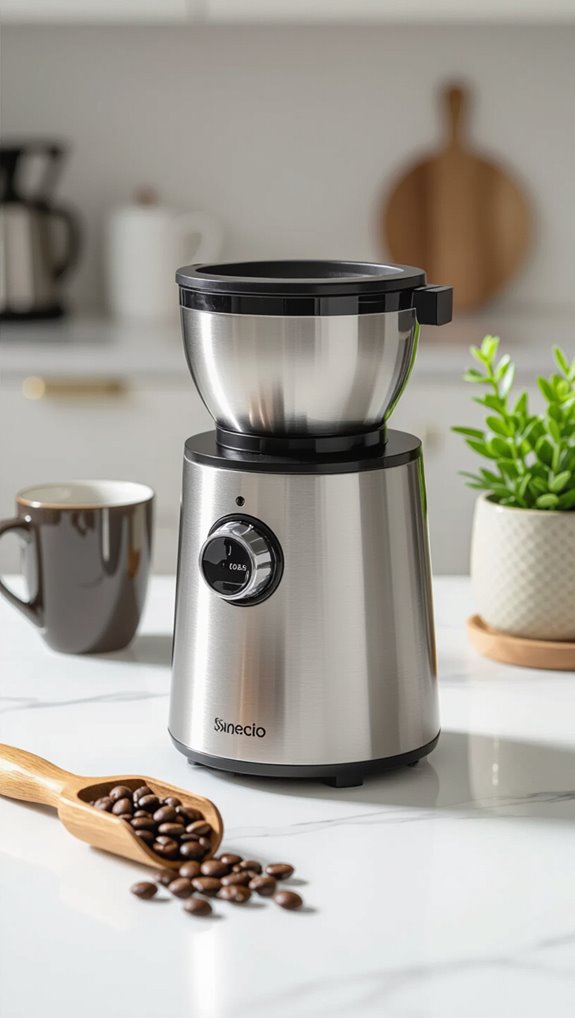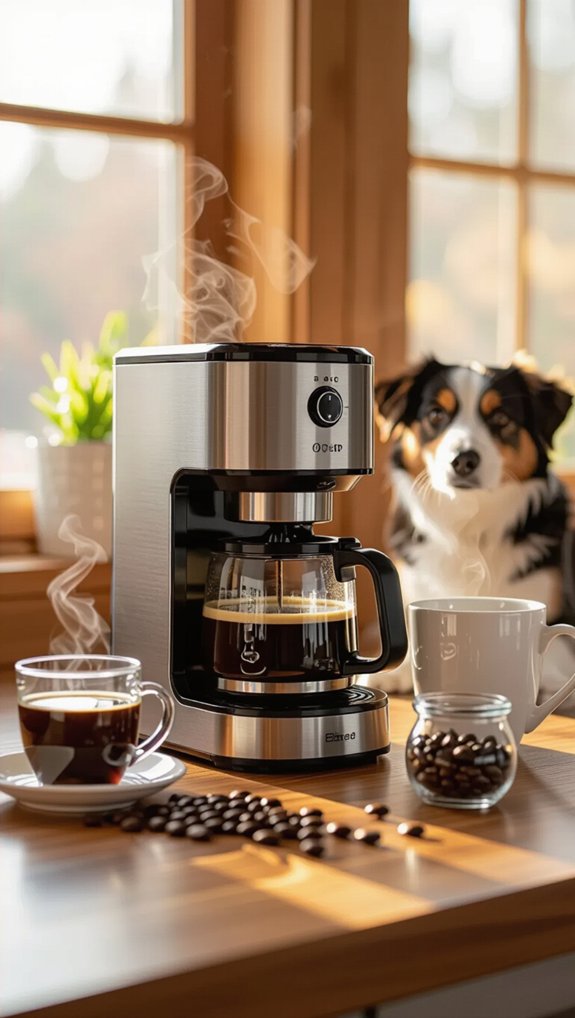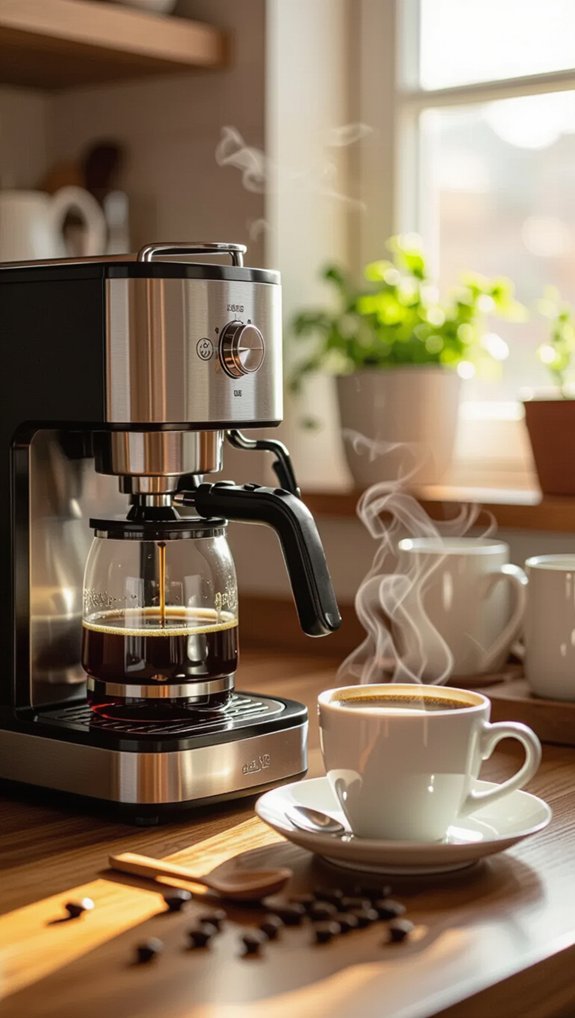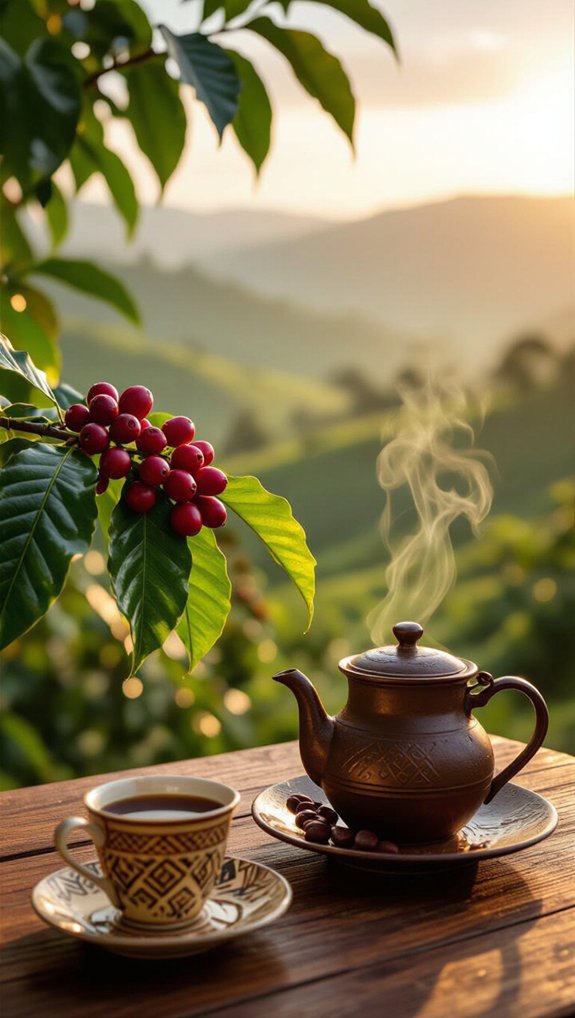Ever wondered what makes Arabic coffee so special that it’s become a UNESCO-recognized cultural tradition? Qahwa coffee isn’t your typical morning brew—this lightly roasted, cardamom-infused beverage has been the cornerstone of Middle Eastern hospitality for centuries, yet many coffee lovers have never experienced its unique, delicate flavors.
If you’re curious about this aromatic tradition, you’re in for a treat. This post will walk you through everything you need to know about qahwa coffee, from its distinctive taste profile and traditional brewing methods to the specific spices that give it character and the cultural etiquette that surrounds serving it. You’ll discover how to make authentic qahwa at home and understand why this ancient coffee ritual continues to bring people together across the Arab world.
Table of Contents
What is qahwa coffee, explained simply
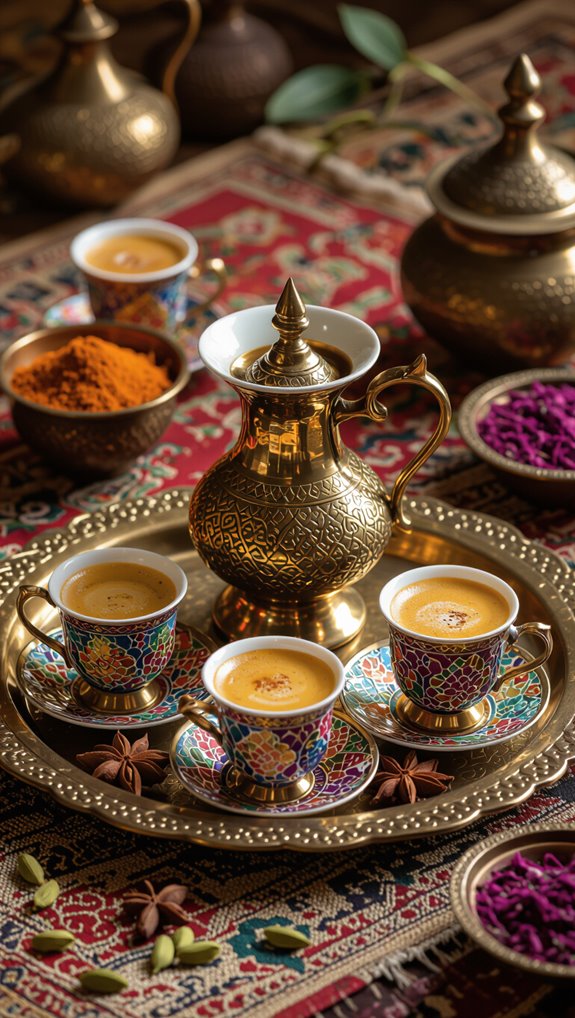
Qahwa coffee is a cherished Arabic brewing tradition that transforms simple coffee beans into a rich cultural experience. It’s a special brew made from lightly roasted beans, traditionally prepared in a dallah (a distinctive coffee pot) and flavored with fragrant cardamom.
The coffee is ground coarsely and simmered gently, creating an earthy, aromatic drink that’s served in small handleless cups called finjān. What makes qahwa unique isn’t just its preparation, but its deep cultural significance—it’s more than a beverage, it’s a symbol of hospitality, warmth, and connection across the Arab world.
Where does qahwa come from originally
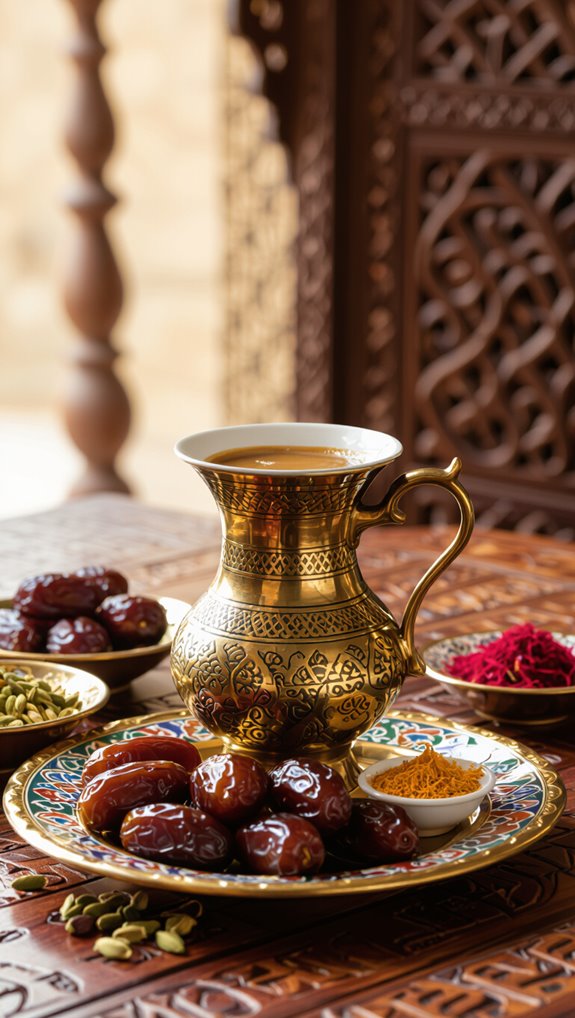
The aromatic journey of qahwa traces its roots deep into the misty highlands of Yemen, where 15th-century Sufi monks first discovered coffee’s energizing potential.
These dedicated spiritual practitioners brewed coffee to stay alert during nighttime devotions, transforming a simple beverage into a cultural phenomenon. Yemeni traders carried these precious beans along trade and pilgrimage routes, spreading qahwa through the Arabian Peninsula and beyond.
The port of al‑Mokha became legendary, with Mokha coffee gaining worldwide recognition. From Sufi monasteries to global trade networks, Yemen’s coffee culture sparked a revolution that would forever change how the world experiences this beloved drink.
What does qahwa taste like, really
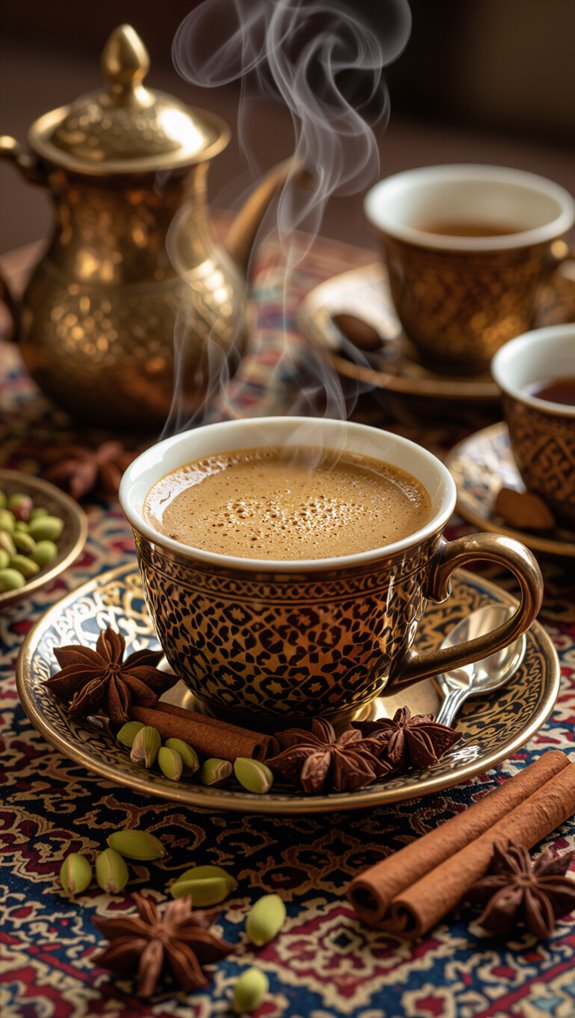
A liquid poem of Arabian heritage, qahwa delivers an earthy, nuanced flavor profile that whispers centuries of cultural tradition in every sip. The light roast Arabic coffee dances with cardamom’s bright, citrusy notes, creating a complex sensory experience that’s both delicate and bold.
| Flavor Component | Characteristic |
|---|---|
| Base Taste | Earthy, Slightly Bitter |
| Spice Profile | Cardamom Dominant |
| Aromatic Notes | Floral, Citrusy |
| Body | Light to Medium |
| Finish | Clean, Palate-Cleansing |
When saffron or rose water join the brew, subtle sweet-spicy layers emerge, transforming this traditional beverage into a liquid narrative of Arabian hospitality and culinary artistry.
How to make qahwa at home
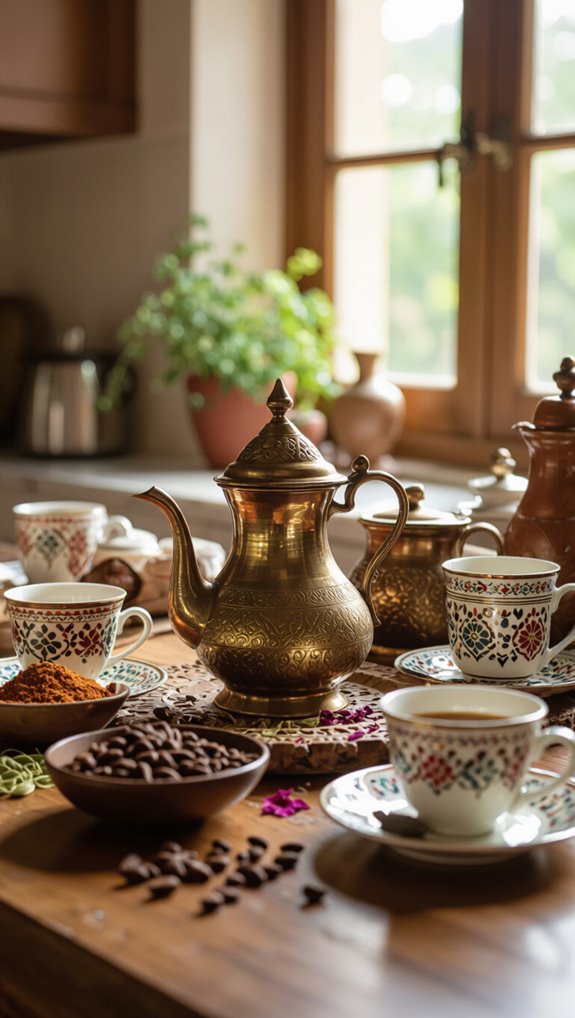
Making authentic qahwa at home is surprisingly simple with just a few key ingredients and traditional tools like a dallah or small saucepan. You’ll need Arabic coffee (light roast or green), water, green cardamom, and optional spices like saffron or cinnamon to create this aromatic Middle Eastern brew.
I’ll walk you through selecting the right coffee, preparing the beans, and mastering the brewing technique that transforms humble ingredients into a rich, ceremonial beverage.
Ingredients
When brewing traditional qahwa at home, you’ll need just a few key ingredients to capture the authentic Arabian coffee experience.
The foundation of this rich beverage lies in selecting the right components for a truly remarkable Arabic coffee.
Essential ingredients include:
- Coarsely ground green coffee beans
- Fresh water
- Green cardamom pods
- A traditional dallah (coffee pot)
- Small finjān cups
The magic happens when you lightly pan-roast your green beans, grind them coarsely, and combine with fragrant cardamom.
Each ingredient plays a crucial role in creating this centuries-old Middle Eastern coffee tradition that’s as much about ritual as it’s about flavor.
Equipment
To dive into crafting authentic qahwa at home, you’ll want to gather a few key pieces of equipment that’ll transform your coffee brewing experience.
A traditional dallah or small saucepan works perfectly for brewing this aromatic coffee. If you can’t find a dallah, an ibrik serves as an excellent alternative.
Essential tools include:
- Coarsely ground coffee beans
- A heat source
- Finjān cups for serving
- Strainer or fine-mesh sieve
Pro tip: Warm your brewing vessel with hot water first to ensure even heat distribution and enhance the coffee’s rich flavor profile.
Instructions
Brewing authentic qahwa requires precision, patience, and a reverence for this centuries-old Arabic coffee tradition. To craft this aromatic beverage, I’ll guide you through the essential steps of preparing traditional Arabic coffee.
- Measure 2-3 tablespoons of coarsely ground Arabica coffee
- Select a dallah or small pot for brewing
- Crush green cardamom pods for depth of flavor
- Bring water to a gentle boil, then simmer
- Carefully decant into warmed finjān cups
Steeped in history, qahwa is more than a drink—it’s a cultural ritual that transforms ground coffee into a ceremonial experience of hospitality and connection.
Signature spices in authentic qahwa brews
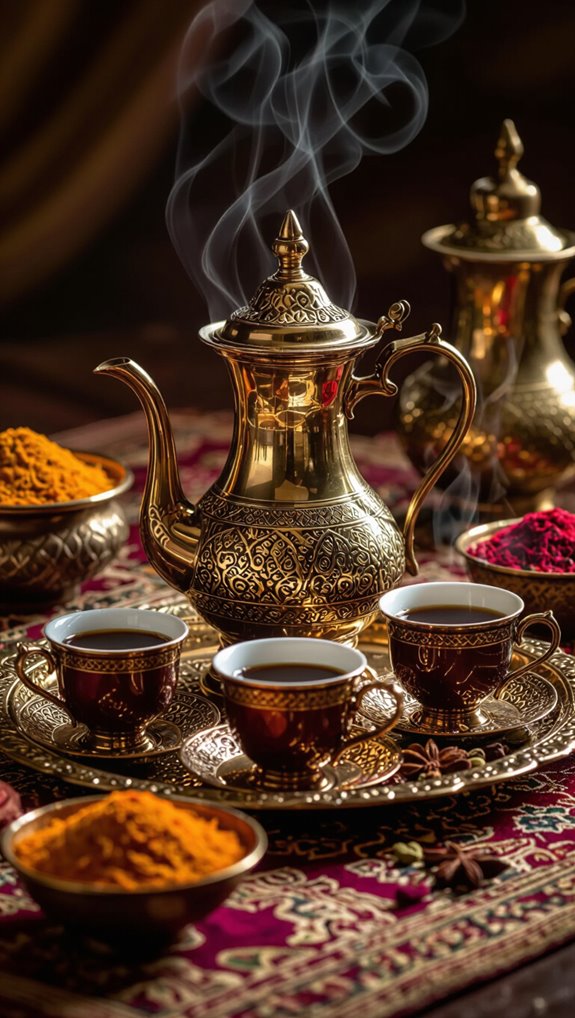
Because cardamom is the heart and soul of authentic qahwa, grasping its role and the symphony of spices in this traditional Arabic coffee is key to mastering the brew. Each spice contributes a distinctive layer, transforming simple coffee into a sensory experience. From crushed cardamom’s citrusy-floral notes to saffron’s honeyed undertones, these ingredients dance harmoniously in the dallah.
| Spice | Flavor Profile | Brewing Technique |
|---|---|---|
| Cardamom | Citrusy-floral | Ground with coffee |
| Saffron | Honeyed, subtle | Steeped with grounds |
| Cinnamon | Warm, sweet-spicy | Pinch during brewing |
Elevate your qahwa with these time-honored spices.
Arabic coffee vs qahwa, key differences
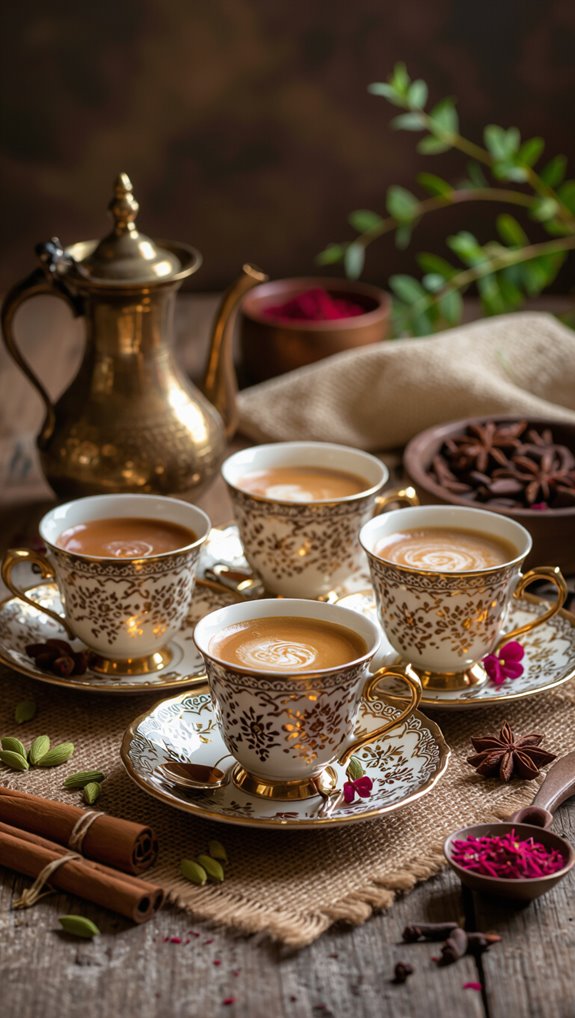
While cardamom’s aromatic dance might’ve captivated your senses in the previous section, grasping the nuanced world of Arabic coffee versus qahwa reveals an even richer cultural landscape.
This distinction goes beyond mere semantics, diving deep into brewing traditions, serving rituals, and flavor profiles.
Key differences between qahwa and Arabic coffee include:
- Qahwa uses lightly roasted Arabica beans, while Arabic coffee varies
- Traditional qahwa always includes cardamom, other regional styles might not
- Dallah pot and finjān cups are specific to authentic qahwa preparation
- Qahwa is typically unsweetened, Arabic coffee can be sweetened
- Serving etiquette is more structured in qahwa ceremonies
Serving qahwa right, cups and etiquette
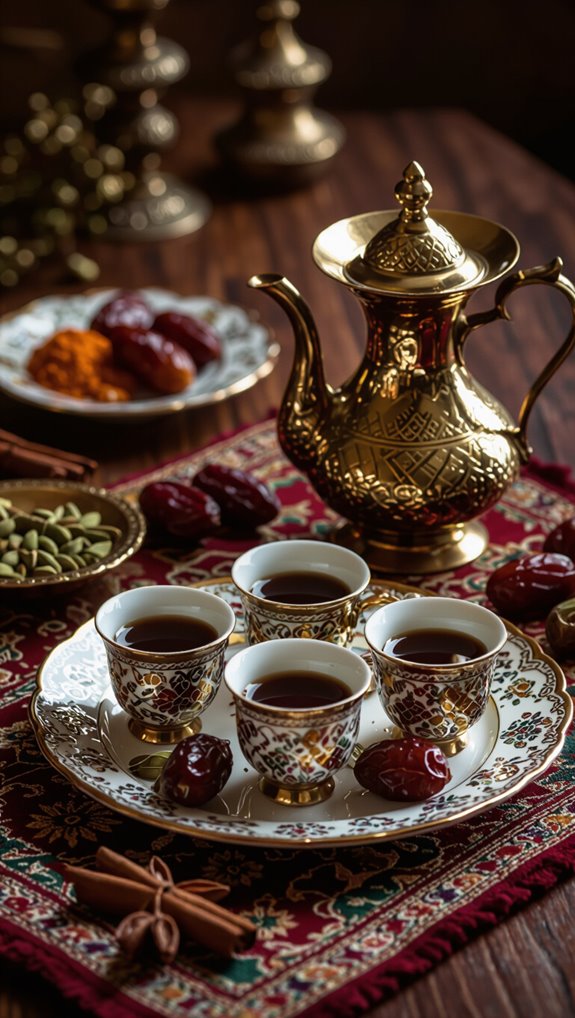
Serving qahwa is an art form that transforms a simple coffee ritual into a profound cultural experience steeped in hospitality and respect. The tradition revolves around small finjān cups and a graceful dallah pouring technique that speaks volumes about Arabic coffee culture.
| Cup Size | Pouring Style | Etiquette |
|---|---|---|
| 30-90 ml | High stream | Right hand |
| Partial fill | Graceful pour | Respect signals |
| Handleless | Hospitality | No left hand |
When serving, always use your right hand and fill cups partially, allowing repeated refills. Signal you’re done by turning the cup slightly or saying “ghair”. The host typically serves the most honored guest first, creating a memorable, respectful coffee experience.
Is qahwa high in caffeine content
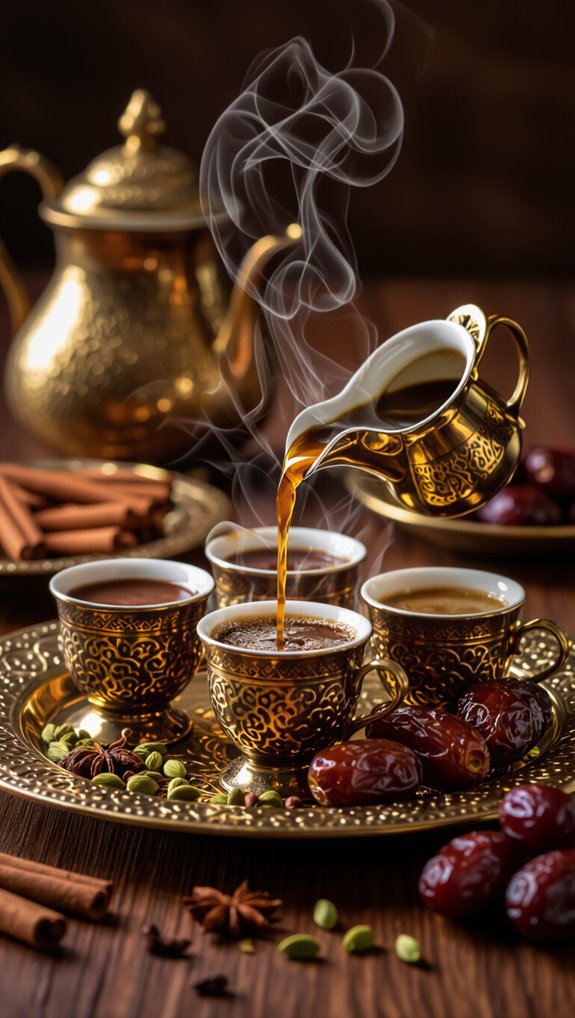
How potent is qahwa’s caffeine punch? Arabic coffee packs a surprising caffeine wallop, with a small 30-60 ml finjān delivering about 40-80 mg of caffeine—comparable to an espresso shot.
Key caffeine characteristics of qahwa include:
- Light roast Arabica beans retain more caffeine
- Traditional serving size influences total intake
- Cardamom-spiced brew doesn’t reduce caffeine levels
- Multiple small pours can total 120-240 mg caffeine
- Brewing method impacts overall strength
This concentrated coffee experience means you’ll get a robust energy boost from these tiny, culturally rich cups of Arabic coffee.
Tips to buy beans and spices
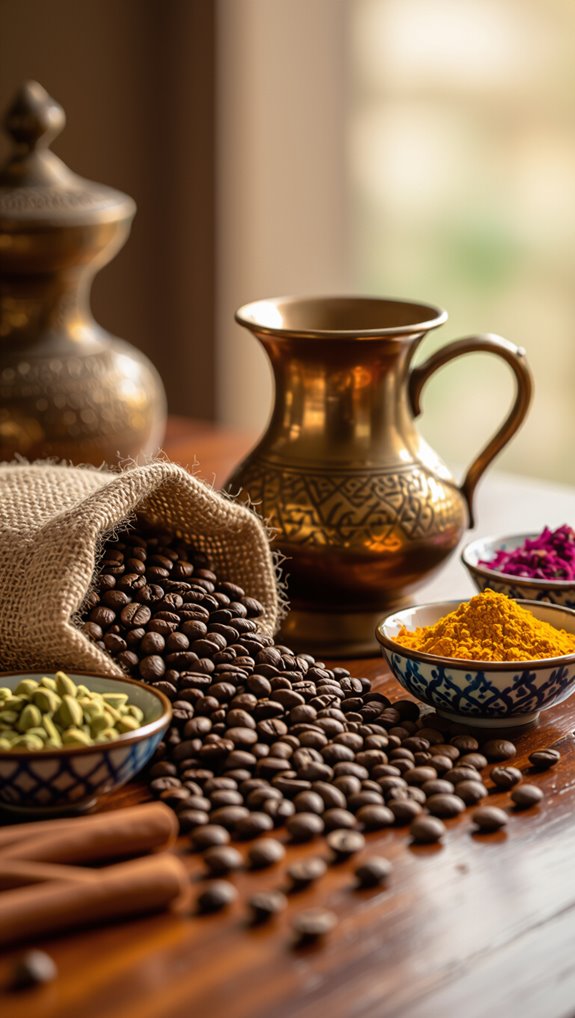
Crafting the perfect qahwa starts with selecting top-notch beans and spices that’ll elevate your Arabic coffee experience from ordinary to extraordinary. Light-roasted Arabica or green Yemeni beans are your golden ticket, with pan-roasting bringing out incredible depth. Choose whole cardamom pods, Grade 1 saffron threads, and fresh whole cloves and cinnamon sticks to ensure maximum flavor.
| Ingredient | Quality Tip | Storage Advice |
|---|---|---|
| Beans | Light-roasted Arabica | Cool, dark container |
| Spices | Whole, fresh | Airtight, away from heat |
| Saffron | Grade 1 threads | Use sparingly |
Pro tip: Freshly ground spices make all the difference in your qahwa’s aroma and taste!
Frequently Asked Questions
How Is Qahwa Traditionally Prepared?
I brew qahwa by simmering coarsely ground green coffee with boiling water for 15-20 minutes, adding cardamom pods, and letting grounds settle before pouring from a height into small, handleless cups.
What Does Qahwa Coffee Taste Like?
I savor qahwa’s earthy, lightly bitter profile, brightened by cardamom’s floral notes. Its clean, spicy finish hints at subtle warmth from saffron or cinnamon, creating a complex, aromatic experience that’s distinctly different from Western-style coffee.
What Spices Are Added to Arabic Coffee?
I add cardamom generously, sometimes saffron for special occasions. Cloves and cinnamon provide warm depth, while rose water can offer a delicate floral touch. These spices are typically mixed with coffee grounds during brewing to create a rich, aromatic experience.
What Is the Etiquette for Arabic Coffee?
I always serve Arabic coffee with respect, pouring small portions into finjān cups, starting with the most honored guest. I’ll use my right hand, accept gentle refusals, and continue pouring until they signal they’re finished by shaking their cup.
In Conclusion
Qahwa is more than just coffee—it’s a cultural experience that connects people through centuries-old traditions. This unique Arabic coffee offers a delicate blend of spices and careful preparation that makes every cup a sensory journey worth savoring. Understanding what qahwa coffee truly represents opens a window into Arab hospitality and culinary artistry that spans generations.
Whether you’re a coffee enthusiast or cultural explorer, discovering qahwa’s rich history, distinctive flavors, and meaningful serving rituals can deepen your appreciation for this traditional brew. If you’re inspired to explore different coffee experiences at home, you can check out our coffee machine reviews to find smart, well-reviewed options that might help you experiment with various brewing methods and coffee styles. Enjoy your qahwa adventure!

